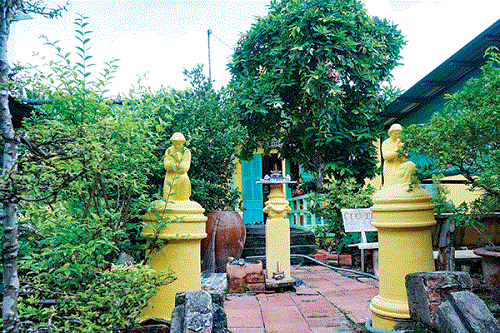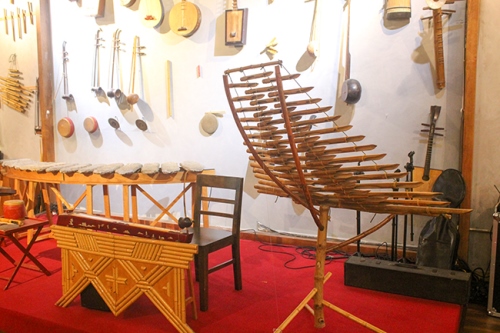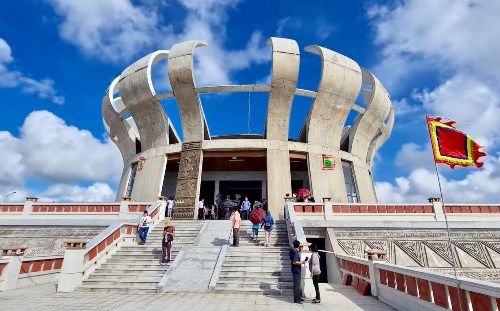
Seniors living their whole life in Can Tho still remember vividly what happened. Few of these happenings are mentioned in a couple of pages in "Can Tho Xua va Nay" by Huynh Minh (published in 1967 by Canh Bang Publishing House). Fortunately, on our field trip along Huynh Thuc Khang Street, Ninh Kieu District, we "ran into the successor" right at Thay Cau Garden. His third-generation showed us the interior of the house and his grave. Furthermore, we were told about the well-known botanical garden of Tay Do (The Capital of the Western South) in the old days (Can Tho now).
The synthesis from his descendants’ stories, his grave’s information, and the documents in "Can Tho Xua va Nay" shows that his real name is Doan Huu Cau, a lawyer, practicing at the Can Tho Court. He was born in 1887 and died on March 25th, 1960 (on lunar February 27th, Year of the Rat), at the age of 73. With his great love of nature, he transformed his family property into an ecotourism destination. As a man of an inquiring mind and good command of knowledge, he went here and there collecting architectural quintessence to draw a draft, and then gradually created the work. The garden is as splendid as a park, and according to author Huynh Minh, even "somewhat more than another". The garden was as magnificent as a park. However, according to Huynh Minh, it was "somewhat more diverse than an ordinary park". There was a fishpond covered with lotus, lots of exotic species of flowers, and ornamental plants exquisitely shaped on the campus. Additionally, he raised some animals such as pythons and leopards. Notably, Thay Cau collected and grew “sen nia”, a type of lotus with giant leaves successfully. He put effort into importing new species of plants to Can Tho in the early days.
Along the lotus pond were a lot of stone benches for tourists to rest and enjoy the sights. In the 1930-1931 period, when Thay Cau was alive, he meticulously cared for the garden. This beautiful garden attracted a lot of tourists, especially on weekends. More impressively, he built a bridge over the pond from the front door where he could do some sightseeing every day and tourists could view the lotus pond and the entire garden. Along the flower beds, he had small ornamental fish tanks installed to serve tourists. The interesting thing is that now, his grandson also maintains the ornamental fishery and pursues his predecessor's passion for ornamental plants.
Thay Cau Garden is opposite Cai Khe Canal and is located in Alley 149 leading to Giac Linh Pagoda, Huynh Thuc Khang Street (formerly known as Cong Quynh Street), An Nghiep Ward, Ninh Kieu District. After his death, the garden lacked caretakers, so it was not as beautiful and spacious as before, but it is always worth visiting. Thay Cau had passed away by the time Huynh Minh was writing "Can Tho Xua va Nay”. According to what Ms. Doan Tuyet Trinh, his fifth daughter, told the author, “Although the garden is no longer covered with different colorful and fragrant flowers, apricot blossoms bloom brilliantly along the paths like a breath-taking flowery wood during Tet Holidays. Additionally, it will be a magnificent picture if young women are seen strolling along the path through the wood.”
|
|
|
Portrait of Thay Cau - Lawyer Doan Huu Cau |
The ancient house of Thay Cau is now owned by his grandson’s family. The host showed us around and took us to Thay Cau’s grave. The house was built in the style of Western architecture and a special, rare thing at that time was that the house had a basement. In addition to the stairs to the basement, the owner arranged a closed hatch, now near the ancestral altar. We found the basement cool and noise-free. According to the owner, as time passed, despite some interior loss and changes, the house is in the original condition and has been repainted, repaired, and reinforced recently. The lotus pond was filled in while the front yard was found unchanged and much higher compared to the surrounding area. The small yard was designed in Western architecture with stairs. There were two beautiful angel statues on both sides.
The hostess took us to the grave of Doan Huu Cau nearby. She showed us some decorative street lamps made of concrete with eye-catching patterns. The relic of the old Thay Cau Garden demonstrates the development of Can Tho City. Opposite Thay Cau Garden was Giac Linh Pagoda, a small octagonal house built by his family for worshiping and later dedicated to public use.
Another relic that cannot be overlooked is Giac Linh Pagoda. On the other side of the alley is a small temple where there is a Buddha statue under a sacred fig. It was also passed down from Thay Cau. The temple was built in a high position. People climb up the winding stairs to worship the Buddha. Besides, there is a basement at the bottom. In front of the temple are the French words "AUX PIEDS DU MAITRE” meaning "at the feet of Thay". The Buddha statue remains intact and is worshiped by local people. In the golden days, there was a large sacred fig behind the temple. When its fruits were ripe, they were picked up from the water. Because of soaking in the water for a long time, these nuts turned hard and shiny black. People used them to make nice and meaningful strings of prayer beads. Up to now, the owner has kept a water tank stand and a small ancient jar. These keepsakes are well preserved and cherished.
The former Cong Quynh Street is now the broadened Huynh Thuc Khang Street along the embankment of Cai Khe Canal. The path leading to Thay Cau Garden abounds with apricot blossoms every Tet Holiday was replaced by rows of houses. The scenic beauty of exotic flowers is now a fond memory. Lots of people claim that Thay Cau might be the pioneer of Can Tho ecotourism. However, his garden served his love of nature, beautified human life, and was open to the public free of charge. That generous feature makes the garden more and more popular at that time, yet it is now remembered with regret. Author Huynh Minh drew a conclusion about the garden, "No matter how much life changes, people always tell the old stories of Can Tho. No one will ever forget the renowned Thay Cau Garden."
Source: Can Tho News - Translated by Diep Truong
















